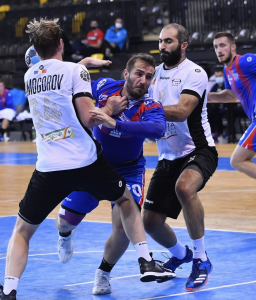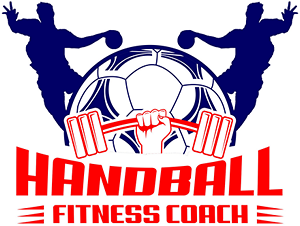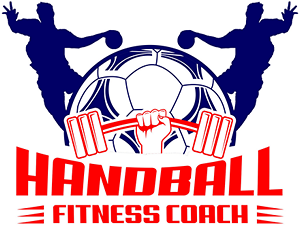Wing & Pivot – Differing Physical Approaches
In our last discussion, we gave a general overview on the way in which positional differences equate to differing physical requirements – and then how this translates to differing priorities in physical preparation.
So I thought I would give a more specific example of what the differences in approach would translate to for 2 different positions – the pivot and the wing.
Physical preparation for a pivot is probably the closest thing in physical preparation for handball that you will get to your standard hypertrophy and strength type of program (or what may be referred to a ‘old school’). What I mean is, almost all of the gym programming for this position is very much based around gaining a combination of muscle size and general whole-body strength (with standard methods), with less consideration for explosiveness, or power, or any of the more ‘fancy’ elements.
That is not to say that you just go out and do a stupid bodybuilding routine, there are still more optimal ways to train for this positions requirements. It is just that putting on some extra size as well as strength but potentially at the expense of some ‘athleticism’ isn’t as much of an issue for this position as compared to say a back and certainly a wing. As a result, there is less of a balancing act required here.
So just a reminder of the 2 basic tables from the previous article.


So with a premium placed upon functional hypertrophy and maximal strength, what would this translate to in practice?
‘Bang for your buck’ – training compound movements
Strength training for the pivot position should be based almost exclusively around compound exercises involving many muscles and muscle groups and almost eliminate all isolation exercises like bicep curls and shoulder abductions. You may love the way your arms look in the mirror when you do them, but if you want to stop kidding yourself and focus fully on training to be a handballer, don’t waste your time doing these, or at least only perform them after all the important functional work that will be of benefit has been completed. Aside from these reasons to drop isolation training and focus on the compound stuff;
- Far more carryover in training adaption relevant to match day movements
- Training movements not muscles
- Challenging your nervous system more
- Being far more challenging from a work rate and conditioning point of view too.
There is also the added bonus of being far more time efficient with training. You likely work a full time or part time job, or are a student on top of playing handball, and on top of having a family and social life and all the other things that go with everyday life, and do not have the luxury of being a full time professional athlete. And lets not forget the actual club training sessions and of course match days. So you likely will not have an endless amount of time to dedicate to your strength training program for handball. Therefore it makes sense to pick exercises where you are getting as much work done in as little time as possible. So it should be obvious to want to pick exercises that are achieving the greatest possible result in the limited amount of time that you have at your disposal. Time spent doing bicep curls and tricep-pulldowns is time wasted.
Train on your feet as much as possible
Handball is a game played on your feet, and as a result, a priority must be placed on exercises and training movements standing. Yes there is a place for functional exercises that don’t strictly fit this bill, such as supine pushing exercises (i.e bench press) and various core exercises where you are on hands and knees or closer to the ground in some way. However, these skills and strength must then be integrated into a more functional use by performing exercises which transfer these exercises to a standing environment, as this is where you will have the greatest functional carryover for handball, since handball is played on your feet.
The exercise requires the recruitment and training of deep stabilisers and inner unit muscles
What I am talking about here are all the various muscles inside the body that you don’t see when looking at the mirror, or on the outside of the body. These are all the deep muscles that you won’t see bulging when you exercise and these certainly won’t be the muscles that everyone around you is impressed by....simply because they aren’t visible. However, they are no less important than the outer unit muscles responsible for actual movement.
Key Fact: Stability must always precede force generation
These deep stabilisers are responsible for providing for stability in and around across all your joints, in order for the outer unit muscles that are responsible for the actual movement of the body, to have a solid foundation to fire or function from, and to move in the most efficient manner, whilst avoiding injury. To give a good analogy of why this is important, I will take from the work of world- renowned holistic and corrective exercise practitioner Paul Chek. Paul uses the old expression that ‘you cant fire a cannon from a canoe’ when talking about exercise and movement in general. In other words, if you don’t have a solid foundation deep (around the hips, spine, shoulders, ankles, knees, core, etc) then you can’t expect to move or perform efficiently, and certainly cant expect to perform at a high level for very long without injury.
Therefore performing exercises that also require the use of the deep stabiliser muscles is what must be included in a truly functional training program for handball. For example, a standing cable press is fantastic in this sense, as you will not just be using the obvious outer unit muscles (pecs, triceps and anterior deltoids), but will also be firing all the stabilisers in and around your shoulder complex, in order to provide the platform to push from, as well as – in even more importantly - the stabilisers around the hips, and also the inner unit core muscles. Believe me, you will realise exactly what I mean when you do these exercises....or at least your body will. Whereas on the other hand, a seated chest press on a pin-loaded machine, or even a plate- loaded machine, is useless!..... All you will use are those outer unit muscles (pecs, triceps and anterior deltoids), as you aren’t required to stabilise the weight at all, because the machine is providing all the stability. All you need to do is push. Just take a look at what a body-on-body contest looks like.



So overall, exercises that would make up the backbone of strength program for the pivot;
As mentioned, nothing fancy here;
-Squat
-Trap bar deadlift
-Split squat
-Romanian deadlift
-Horizontal Pressing: Bench press AND standing cable press, rotate with incline bench presses
-Pull Ups (where possible, even if repetitions are low)
-Lat pulldown – using independent columns
-Tripod row
-Landmine Press
In regards to more powerful or explosive movements;
-Medicine balls – rotation based, but especially chest pushing-focused, due to high volumes of body-on-body contests
-Olympic lifts if you are proficient in them – it has to be said, many players in this position, due to body size and lever lengths, will be completely incompatible with Olympic lifts. They are not the be-all end-all
-Plyometric work, particular hops, jumps and bounds are much less of a priority than say for a back or wing.
Just to reiterate, full body strength and functional hypertrophy are the primary indicators of physical progression within this role.
In a very general programming sense, you would be looking at alternating between slightly more volume at relatively lower loads, and slightly more load at relatively lower volumes, or what the late and great Charles Poliquin terms, alternating between periods of accumulation and intensification.
So just a very quick example with 2 key exercises;

So now by comparison, lets go the wing player
As previously mentioned, the more ‘athletic’ qualities are important within this role. When I say athletic I mean the more traditional ‘movement-based’ abilities. Players out wide need to benefit from speed and agility, more lateral movements, and longer sprints, due both to the role within the game, as well as their smaller stature (which came first in this regard – the chicken or the egg?....I am unsure).
Once again, compound exercises form the majority of the training program. But here, given the importance of the more athletic movements, slightly more nuance required than for the pivot. So by comparison, here are a few differences;
Strength is still important, but maximal strength less important
There becomes less body-on-body contests in this role, and the key success areas here rely less on maximal and repeated maximal strength efforts. Strength however, is still important in providing a foundation for athletic quality/speed/power as well as of course robustness to injury. It is merely the methods by which it is trained, and the extent to which they are trained.
More emphasis on unilateral work
This is particularly the case with lower body work. There is naturally still a place for things like squatting and trap bar deadlift, but given the greater emphasis on athleticism in match performance, and therefore a greater transfer of training being ideal from strength gains, single-leg work becomes more important. So things like rear foot elevated split squat and lateral lunges. Unilateral upper body work also becomes more important, given a greater level of importance on rotation and shooting.
More lateral movement/frontal plane exercises
With more lateral movement – in both offensive and defensive phases, training strength and power qualities here are important. This is particularly the case with shooting – how often do you see a wing player get around a defender by getting close to the goal line/baseline, and then powerfully laterally pushing back inside to open up the goal mouth, before taking their shot. Powerful lateral movement is a necessity if you play out wide.
Hamstring robustness
This is very broad, and there are various methods to use here, however suffice to say, that given the larger sprint distances and sprint distances that a winger performs (in large part due to their role in counter attacks), hamstring robustness and therefore strength becomes vitally important.
Let’s not forget, much of this robustness will also come from specific speed work, however from a strength programming point of view – unilateral exercises are important, as well as high loads if bilateral (this is the one area where more maximal loads are still vital for this position – as you can see, there are no black and white rules in all circumstances.) These should also be hip-dominant (proximal) – example single leg RDL as well as knee dominant (distal) – example single leg curl.
Less emphasis on the maximal upper body compound
Does this mean no bench press or push ups or pull ups. No it certainly doesn’t, it merely means less emphasis. They are less important, and will transfer less to success than they will if you are a pivot for example. That doesn’t mean don’t do any upper body strength work at all – it still plays an important role in the overall program. It is just that continuing to load up your bench press to higher maximal levels probably will not provide you with the extra bang for your buck from the time you dedicate when compared to the other options we have just covered.
More specificity to shooting
And just building on this upper body theme to clarify what I am saying, let’s relate this in with shooting Lets take the throw component of a jump shot at the goal. Jumping and shooting involves a complex combination of movements including stepping, rotating and pushing – with the throw portion of the movement being combination of some pushing as well as a very strong shoulder rotation and torso rotation. Suffice to say, a standard bench press will do very little for this goal – as will a lying dumbbell press on a Swiss ball. A single arm lying press on a Swiss ball would make a better starting point in developing a foundation of strength in this movement – being single sided (or unilateral.) But once again, with the movement we are aiming at developing being performed on the feet – transfer into a movement like a single arm standing rotation and push on a cable is required. Of course there will be more that goes into training strength and power in a jump shot, but we are just simplifying the actual throwing portion of the movement to highlight that even though this throwing portion is predominantly and upper body movement, it is still of utmost importance to train it in a standing pattern, to have the most effective level of carryover to a situation in a game. Indeed we breakdown and cover the various components of shooting in detail in Strength & Power for Handball.
Once again here, am I being absolutely black and white and saying don’t bench press if you play wing? NO! I am saying in this role, due to demands such as a greater emphasis on shooting, will require more nuance when it comes to transferring and linking in this strength to more dynamic movements in a game such as shooting.
So overall, exercises that would be more prominent in the program of a wing;
-Rear foot elevated split squat
-Single leg RDL
-Multi direction lunge
-Single leg hamstring curl
-Single arm standing cable press + twist, Dumbbell press
-Pull Ups
-Lat pulldown – independent columns
-Tripod row
-Landmine Push Press
In regards to more powerful or explosive movements;
Here plyometric work becomes much more prominent and central in adding a powerful component to the training. Lateral bounds, multi directional hops, and even standard bilateral jumps such as box jumps become central to not only performance, but especially so to robustness to injury.
Medicine balls also remain an important tool, in training rotation based power and explosive pushing power, but also things like dynamic shoulder stability.
In regards to translating this to a program, what this will mean is that slightly more nuance is required than the strong emphasis on larger lifts, relatively simpler movements, and alternating between general periods of strength and hypertrophy as in the general pivot approach. With more athleticism required, and the inclusion of more plyometrics too, the overall program while following all the same principles would look quite different (particularly when adding in the conditioning component).
But here is a very quick example with 4 key exercises in each – in what I would place in a quality general program for a wing;


So hopefully it is clear, that while we are training for the same sport, positional differences and even role differences within these positions (and therefore the type of game you play) will dictate the specifics of your programs. I must be clear I have used generalisations here – particularly around the differences in position and the types of players who play those roles. There is no one way – however hopefully this discussion gives you an indication of how, based on the differences in general physical demands of positions then translates to differences in approach to how you go about training – specifically the gym work.
By all means, feel free to continue to send through questions that continue to inspire the article content. As far as absolute specifics, these will always depend on the individual and their personal background and situation.
Fitness Coach

